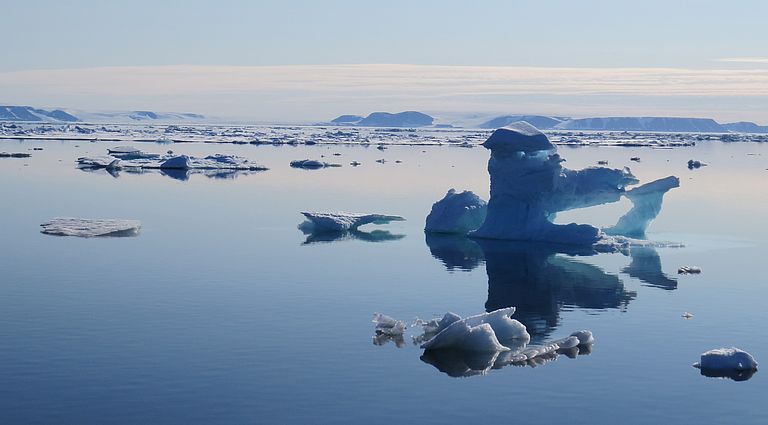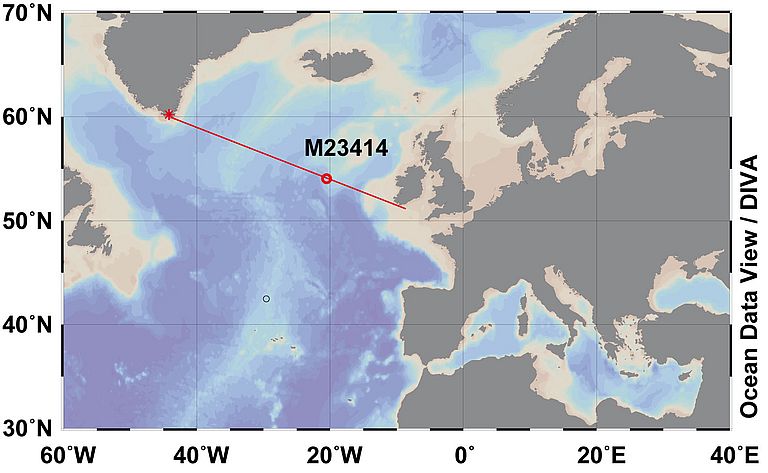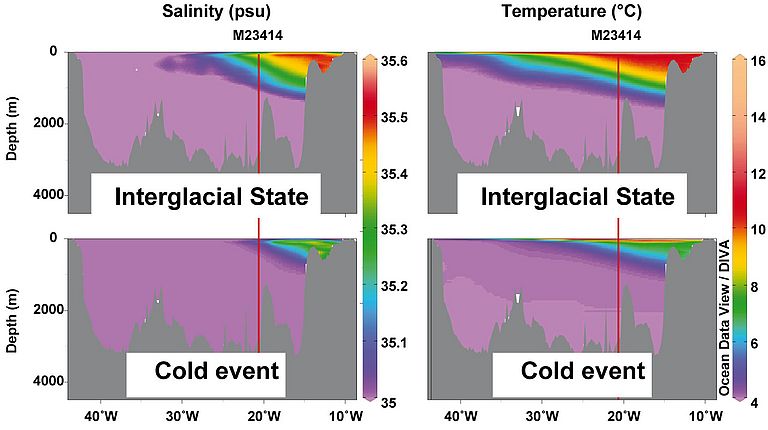Melting Greenland ice has changed ocean currents
German-Dutch research team found evidence of a pronounced cold phase in the warm period occurred some 400,000 years ago
The current observations register visible signs of a global climate change: In 2016, the global temperatures achieved a new record and the ice cover of the Arctic and the Greenland ice sheet have been decreasing for many years. But what do these changes mean for the future? In order to answer this question, scientists compare the present climatic situation with those epochs of the earth's history, for which similar climatic features have been characteristic. One of them, called MIS11 (Marine Isotopic Stage 11), occurred about 400,000 years ago and lasted around 30,000 years. During this epoch the Earth grew warm so strongly that Greenland ended up being largely free of ice, while the sea level was probably 6 to 13 meters higher than today.
The scientists from GEOMAR Helmholtz Center for Ocean Research Kiel, the Dutch Marine Research Institute (NIOZ) and the Alfred Wegener Institute Helmholtz Center for Polar and Marine Research (AWI) in Bremerhaven, have shown by using sediment samples, that during MIS11, there were hundreds-year long cold phases in the northern hemisphere which occurred after the main warming took place. "These cold phases were accompanied by significant changes in the ocean circulation", explained Dr. Evgenia Kandiano, the first author of the study, the palaeo-oceanographer, who has worked at both GEOMAR and NIOZ.
For the purposes of this study the researchers have investigated a sediment core from the sea bottom of the North Atlantic. Besides calcareous shells of marine organisms, the sediments contain organic compounds of ocean entities, which inhabited different water depth layers. These remnants sunk to the sea floor for over several hundred thousand years. They contain information about the environmental conditions of earlier times. The researchers have obtained nine independent data series from calcareous shells and organic compounds of different biological species, which had been deposited on the sea floor during MIS 11. All of them consistently showed the temporary cooling of the sea water, after the global warming has occurred. "Since the studied material belonged to different organisms which lived at different water depths, we could even see a development of cooling according on the water depth,” explained Dr. Kandiano.
First the sea water cooled on the surface, later the process had also affected the medium and deep water layers. "This process took place due to the fact that the melting Greenland glaciers had released so much cold freshwater into the North Valley during the warm period of that time, that this freshwater pushed the more salty and warmer water to greater depths. As a result, the near-surface heat input from the Gulf Stream had been weakened significantly," Dr. Kandiano explains.
A similar scenario could also occur now due to present global warming. The observational data have already shown, in some areas of the North Atlantic, that a decrease in the salt content took place because of the meltwater input. However, the observations did not yet indicate a slowdown of circulation. "Not all questions regarding MIS11 are resolved yet; therefore, it seems rather difficult to make a direct comparison with the present climatic situation. However, we can verify a direct impact of the melting Greenland ice on the ocean currents in the past," remarked Dr. Kandiano. The increased supply of freshwater at the sea surface in the cold regions of the North Atlantic leads to an increased spread of sea ice in the winter. "The seasonal fluctuation of the sea ice extent has not only an effect on the ocean, but also directly affects the weather," noted a co-author from the AWI Dr. Henning Bauch. "Thus, the mechanism does not only affect the relatively slow processes in the ocean, but also has a direct overregional influence on many other parameters of our climate system due to a reaction of the atmospheric processes," said Dr. Bauch.
Note:
This study was funded by EU in frame of Marie Curie Actions – Intra-European Fellowships for Carrier Development (grant agreement 302442 (PICKS), Deutsche Forschungsgemeinschaft (DFG), Dutch Organization for Scientific Research (NWO), and Netherlands Earth System Science Centre (NESSC).
Original publication:
Kandiano, E. S., M. T. J. van der Meer, S. Schouten, K. Fahl, J. S. Sinninghe Damsté, H. Bauch (2017): Response of the North Atlantic surface and intermediate ocean structure to climate warming of MIS 11. Sci. Rep. 7, 46192; http://dx.doi.org/10.1038/srep46192
Conact:
Dr. Andreas Villwock(GEOMAR, Communication & Media), Phone: +49-431 600-2802, presse(at)geomar.de





